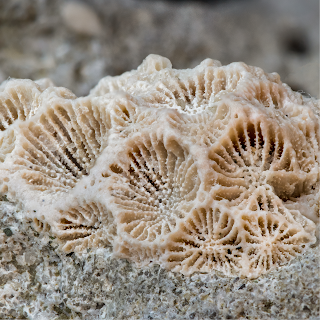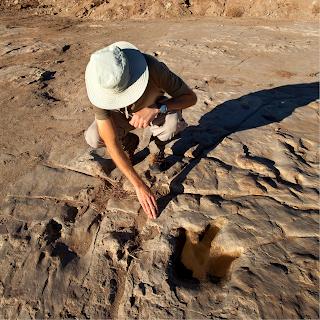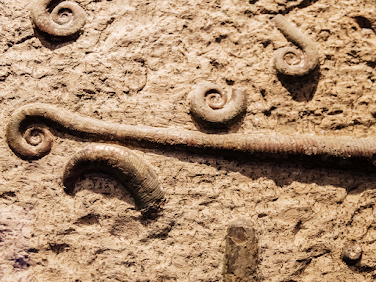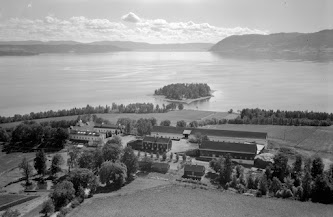Near Cranbrook, the Eager Formation outcrops at several locations just outside of town. This particular lovely is from the Rifle Range locality and is in my collection at 98-CR-EF042 — meaning it was collected in 1998 and the 42nd find of the day. This is a prolific site and with diligent collecting, you can find many wonderful specimens of scientific and aesthetic value in the course of a day.
The Rifle Range locality sits on the Silhouette Rifle Range — which is literally on a rifle range where folks go to shoot at things.
The fossils we find here are just a shade older than those found at the Burgess Shale. Burgess is Middle Cambrian and the species match the Eager fauna one for one but the Eager fauna are much less varied.
Olenellus is an extinct genus of redlichiid trilobites, early arthropods, that litter this glorious Cambrian site. Olenellus is the only genus currently recognised in the subfamily Olenellinae. The sister group called the Mesonacinae consists of the genera Mesonacis and Mesolenellus.
Olenellus range in size but are about 5 centimetres or 2.0 inches long on average. They lived during the Botomian and Toyonian stages, Olenellus-zone, 522 to 510 million years ago, in what is currently North America in what was part of the paleocontinent of Laurentia.
Olenellus are both common in and restricted to Early Cambrian rocks — 542 million to 521 million years old — and thus a useful Index Fossil for the Early Cambrian.
Olenellus had a well-developed head, large and crescentic eyes, and a poorly developed, small tail. The fellow you see had a bit of his tail crushed as he turned to stone.
Trilobites were amongst the earliest fossils with hard skeletons. While they are extinct today, they were the dominant life form at the beginning of the Cambrian and it is what we find as the primary fossil in the fauna of the Eager Formation.
 |
| A slightly crushed lingulida brachiopod |
The specimens of Wanneria from here are impressively large. Some are up to thirteen centimetres long and ten centimetres wide. You find a mixture of complete specimens and head impressions from years of perfectly preserved moults.
From July 21 to 31, 2015, the Royal Ontario Museum (ROM), under the direction of Dr. Jean-Bernard Caron carried out a palaeontological dig at an exposure of the Eager Formation that outcrops between Cranbrook and Fort Steele in the East Kootenay Region of British Columbia.
The team included David George (APS), Dr. Bob Gaines (Pomona College), Dr. Jean-Bernard Caron (ROM), Dr. Gabriela Mangano (University of Saskatchewan), Maryam Akrami (ROM), Darrell Nordby (APS), Joe Moysiuk (University of Toronto), and local, Guy Santucci (APS and project field co-ordinator), and Dr. Mark Webster (University of Chicago).
Dr. Caron was interested in the fauna of the Eager Formation as there is an overlap with the Burgess Shale species — the Eager is a window into time 513 million years ago — 8 million years earlier than the Burgess.
 |
| Lower Cambrian Brachiopod |
Their excavation of the site was thorough — reducing all of the potentially fossil-bearing strata to pieces the size or smaller than a dinner plate. The 2015 team used a backhoe to take off the weathered top layer and get down to the bedrock below.
It has been six years since their visit and we will hopefully see some worthy publications from their efforts. There had been talk of multiple publications stemming from the spectrum of species, a comparison to the Burgess fauna and papers on the trace fossils. I checked in with Joe Moysuik from the University of Toronto who had been on the dig in 2015. To his knowledge, no new papers have yet to be published — though, Caron has been a busy bee on a sexy new nektobenthic suspension feeder from the Burgess material. I am rather hoping their team sorts out the naming of some of the species and gets them to publication so we can finally put them to bed.
Days after my correspondence with Moysuik, Chris Jenkins, a Cranbrook local and huge contributor to our knowledge of Upper Cambrian trilobites, shared an exciting find.The two had met some 10 years previous when Don, an avid outdoorsman and Jenkins' neighbour, had wandered over to see what all the rocks were about in Jenkins' yard.
Tales of trilobites and a lifelong friendship ensued. It was also the beginnings of shared fieldwork. This time, it was to outcrops of the Eager Formation just outside of Cranbrook. Together, the two unearthed a three-foot-wide band of Eager Formation bedrock. Not unusual in and of itself — but instead of the usual trilobites — this rock revealed several varieties of Lower Cambrian brachiopods.
Jenkins shared photos of at least three different types of brachiopods — potentially new fauna for the Eager. Although they superficially resemble the molluscs that make modern seashells, they are not related. Brachiopods were the most abundant and diverse fossil invertebrates of the Paleozoic — over 4500 genera known; the number of species is far greater. So, naturally, we had expected to find brachiopods in the Eager Formation as they were abundant in Lower Cambrian seas — but so far they had eluded us.
And, interestingly, the rock containing the brachiopods is devoid of any trilobite specimens — not a one. Have they found a wee slip of the Eager Formation that records a nearshore environment or have they stumbled across a segment that records another time period altogether?
The brachiopods you see in the photos above are roughly 1/4 inch to 3/4 inches. Should Caron and team return to the site, these new brachiopods will be of great interest as they look to rewrite the geology and palaeontology of the site and region.





































